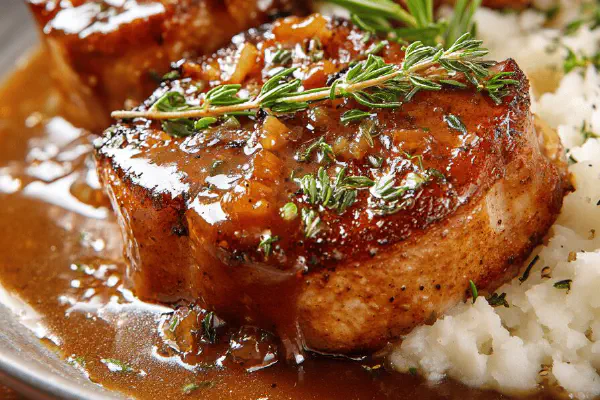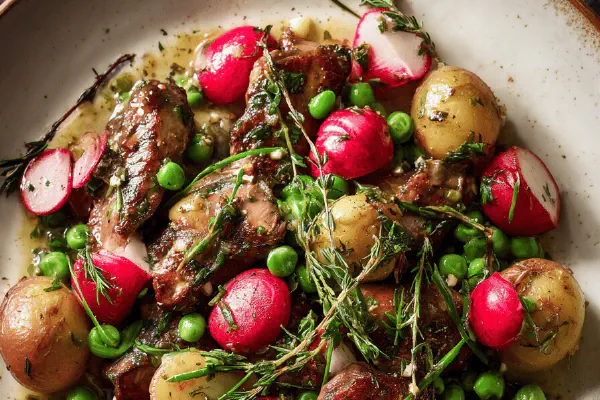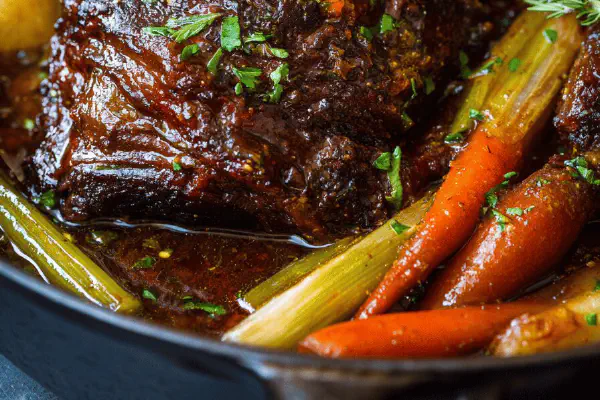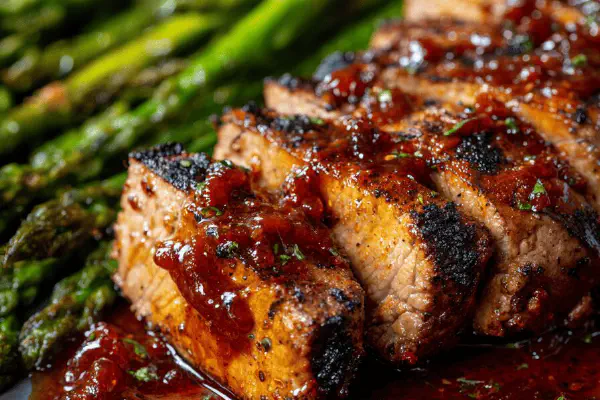Pork Chops with Honey Maple Pears
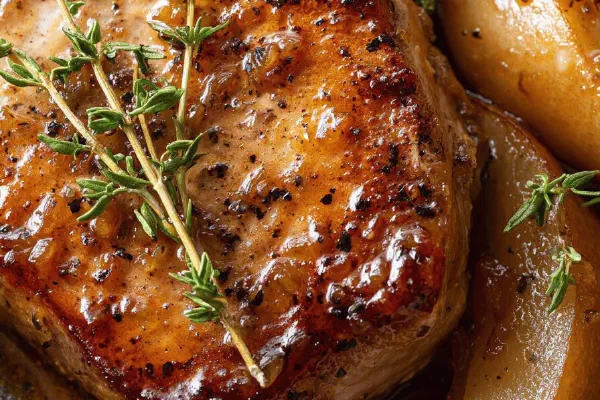
By Emma
Certified Culinary Professional
Ingredients
Caramelized Pears
- 2 pears ripe but still firm, peeled, halved, cored
- 25 ml butter softened (~1 ½ tbsp)
- 20 ml honey maple syrup (~1 1/3 tbsp)
- 20 ml white wine vinegar (~1 1/3 tbsp)
- 3 garlic cloves crushed
- 3 sprigs fresh thyme
- 100 ml chicken broth
Glazed Pork Chops
- 4 pork chops bone-in about 2.5 cm (1 inch) thick
- 20 ml honey maple syrup (~1 1/3 tbsp)
- 20 ml white wine vinegar (~1 1/3 tbsp)
- Salt and freshly cracked black pepper
- Butter or neutral oil for cooking
About the ingredients
Method
Caramelized Pears
- Heat a large heavy skillet over medium-high. Melt butter until foaming but not brown. Lay pears cut side down listening for the sizzle and watch the edges start crisping and coloring – that caramel smell should peek through around 3 min. Flip gently once golden, add honey maple syrup, white wine vinegar, garlic, and thyme. The garlic should smell sweet not burned, so toss or bury it early if needed. Roast pears total 8-10 minutes turning them occasionally till just fork-tender, skin should hold but be softly translucent. Remove pears carefully, set aside warm without garlic and thyme.
- Pour chicken broth into the pan. Scrape browned bits with a wooden spoon. Simmer briskly reducing 2-3 minutes until slightly syrupy coating consistency. Remove broth reduction from heat, set aside.
Glazed Pork Chops
- Clean the same skillet, add a pat of butter and a splash of oil to keep it from burning. Bring heat to medium-high. Pat chops dry with paper towels (don’t skip this or they’ll steam). Season generously with salt and pepper. Lay chops away from you to avoid splatter. Should hear a firm sizzle. Cook undisturbed about 6 minutes or until a deep golden crust forms, edges show slight browning. Flip, same for the other side. Lower heat if butter blacks too fast.
- Add honey maple syrup and white wine vinegar on top, tilt pan carefully, spoon glaze repeatedly over chops while cooking another 2-3 minutes. Glaze should thicken, become sticky but not burn. Cooking this way lets the sugar caramelize without bitterness. Test doneness by slight springiness to touch or using an instant-read thermometer (about 63°C, 145°F). Rest for 5 min under tented foil.
- Return pan to medium heat, add reserved pear broth. Boil rapidly to reduce again until nappe-like coating that clings when spoon lifted (about 4-5 min). Watch carefully to avoid burning. Should smell sweet acid tang with a whisper of thyme.
- Plate pork chops and pears together, spoon reduction sauce over everything generously. Serve with mashed potatoes or a robust green, maybe grilled asparagus or garlicky kale. The acidity brightens, balance fat, and sweetness ties flavors together.
Cooking tips
Chef's notes
- 💡 Dry pork chops thoroughly before searing. Moisture kills crust formation; pat well with paper towels. Heat pan medium-high but watch butter carefully – it foams, don’t let it burn. Listen for steady sizzle, not popping. Flip once when deep golden edges appear. Glaze thickens fast; spoon repeatedly while cooking glaze 2-3 min max. Watch heat; too hot burns sugar quick, too low loses crust color.
- 💡 Caramelize pears with patience. Butter must foam but not brown. Pears lay cut side down until edge crisps, listen closely to sizzle shift. Flip once golden, add syrup, vinegar, garlic, thyme quickly. Garlic should smell sweet, not bitter or burnt – toss or bury early to avoid harsh flavor. Pears cook 8-10 min, turning gently. Texture tender but skin holds. Remove garlic and thyme before serving.
- 💡 Broth reduction needs attention. After pears removed, scrape browned bits to unlock flavor. Simmer briskly 2-3 min till syrupy but not thick glue. For final sauce, add pear broth back, boil 4-5 min till nappe consistency. Watch closely or sauce burns bitter and sticky. Stir or swirl but no scraping pan too hard to keep glaze integrity. Temperature control critical to keep brightness and avoid overly thick sticky mess.
- 💡 Butter adds flavor and browning not matched by oil alone. Substitute olive oil if dairy sensitive but expect less crust flavor. Garlic form matters; crushed is more aromatic but sliced gives subtle background. Thyme is milder than rosemary, fits pears well. White wine vinegar chosen over cider for sharp acidity that balances sweet maple without overpowering. Small tweaks impact balance, test with small batches initially.
- 💡 Rest meat under foil after cooking 5 min. Lets juices redistribute, avoids dry pork. Meanwhile, reduce broth again to concentrate flavor, thicken glaze. Serve chops and pears warm. Pears lose texture quickly if cold – keep warm gently. Sauce spooned thick over everything adds moisture and ties contrasting sweet, sour, savory elements without separate condiment. Avoid overcrowded pan; cook in batches if needed for even browning.
Common questions
How to know when pears are done?
Soft but not mushy. Skin translucent but holding shape. Listen for sizzle changes, edges golden crisp. Fork test, tender but not falling apart. Garlic aroma sweet not burnt signals right time. Timing varies by pear ripeness.
What if glaze burns?
Lower heat immediately. Sugar burns fast once over 180°C. Spoon quickly so glaze coats but doesn’t blacken. Use neutral oil with butter for higher burn temp. If burnt, start fresh glaze. Don’t stir too vigorously to avoid grainy texture.
Can I substitute broth type?
Chicken broth lighter, less overpowering than beef. Vegetable broth works but might mute pork flavor. Water with bouillon possible but less depth. Avoid broth with strong seasoning to keep sauce balanced. Always adjust reduction time if liquid differs in salt or body.
How to store leftovers?
Keep pork and pears separate in airtight containers. Refrigerate within two hours. Warm gently in pan with a splash broth or water to avoid drying. Sauce reduces and thickens further if reheated too long, add water to thin. Consume within 2 days for best texture; pears soften over time.
